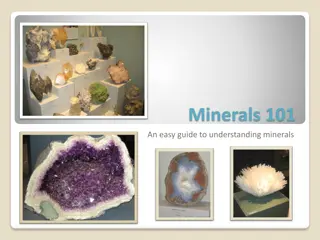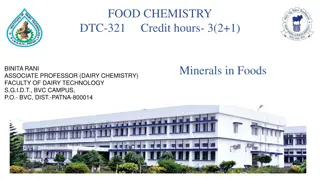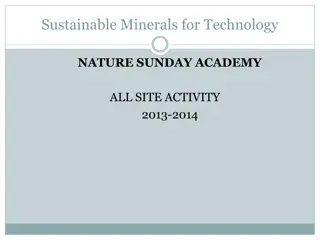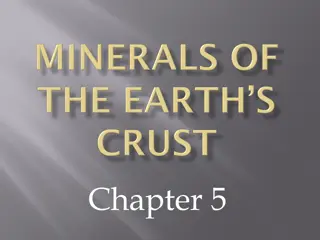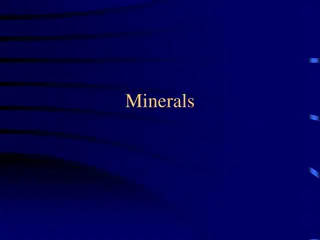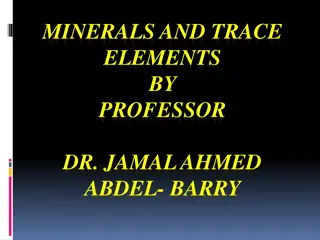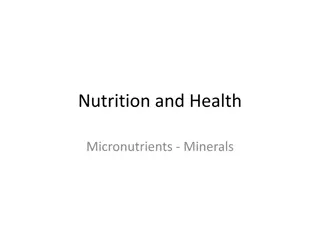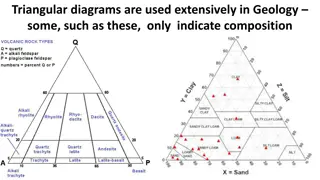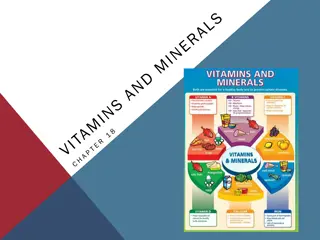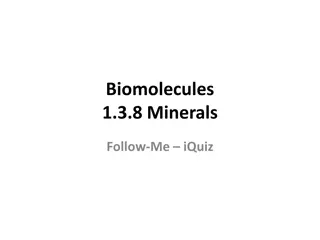Understanding Common Rock-Forming Minerals with K. Guru Brahmam
Explore the six common rock-forming minerals including quartz, feldspar, mica, olivine, pyroxene, and amphibole with insights from K. Guru Brahmam, a lecturer in the Department of Geology. Learn how these minerals are essential tools in classifying rocks and determining their color and composition. Delve into the properties of quartz, plagioclase feldspar, and alkali feldspar, and understand their industrial significance in various applications. Enhance your knowledge of rock-forming minerals through detailed descriptions and visual aids.
Download Presentation

Please find below an Image/Link to download the presentation.
The content on the website is provided AS IS for your information and personal use only. It may not be sold, licensed, or shared on other websites without obtaining consent from the author. Download presentation by click this link. If you encounter any issues during the download, it is possible that the publisher has removed the file from their server.
E N D
Presentation Transcript
Rock Forming Minerals K. Guru Brahmam
K. Guru Brahmam Lecturer Department of Geology K. Guru Brahmam
Six Common Rock-Forming Minerals The six minerals amphibole, feldspar, mica, olivine, pyroxene, and quarts are the most common rock-forming minerals and are used as important tools in classifying rocks, particularly igneous rocks. Except for quartz, all theminerals listed are actually mineral groups. However, instead of trying to separate all the minerals which make up a group, which is often not possible in the field, they are dealt with here as a single mineral with common characteristics. K. Guru Brahmam
Quartz and feldspar are light- coloured minerals; mica, pyroxene. amphibole and olivine are dark- coloured. The colour ofa rock will betermined by the proportions of light and dark-coloured minerals present. If most of the grains are quarts and feldspar then the overall appearance of the rock will be light, while the opposite will be true if the minerals are mainly mica, pyroxene, amphibole or olivine. The colour of a rock with between 25 and 50% dark minerals is Intermediate. K. Guru Brahmam
Common Rock-forming Minerals Quartz Quartz which is usually called silica, is one of the most common minerals in the Earth s crust. Quartz is made up of silicon dioxide (SiOz) Quartz crystals are usually hexagonal and prismatic in shape. Pure quartz is colourless, although the presence of impurities may give a range of colours, such as violet, pink and orange. Quartz is the raw material for making glass. K. Guru Brahmam
Plagioclase Feldspar Plagioclase feldspar is sodium- or calcium rich feldspar. The chemical composition ranges aluminum silicate, NaAlSi3O8 calcium aluminum silicate, CaAl2S2O8 from sodium to Plagioclase feldspar crystals usually occur as study prisms. Plagioclase feldspar is generally white to grey and has vitreous luster. Plagioclase feldspar is an important industrial mineral used in ceramics. K. Guru Brahmam
Alkali Feldspar Alkali feldspar is another member of the family of feldspar minerals. Alkali feldspar (Potassium aluminum silicate (K,Na)AlSi3O8) are rich In alkali metal ions. Alkali feldspar crystals usually occur as study prisms. Alkali feldspar is commonly pink to white. Alkali feldspar is used as raw material to make porcelain. K. Guru Brahmam
Micas Micas are a family silicate minerals. Micas are made up of varying amounts of potassium, magnesium, iron, as well as aluminum, Silicon and water. Micas form flat, book-like crystals that split into Individual sheets, separating into smooth flakes along the cleavage planes. They are common minerals in intrusive igneous rocks, and can also be found in sedimentary and metamorphic rocks. Biotite is dark, black or brown mica; muscovite is light-colored or clear mica. K. Guru Brahmam
Amphiboles o Amphiboles are a family silicate minerals o Amphibole minerals generally contain iron, magnesium, calcium and aluminum as well as silicon, oxygen, and water. o Amphiboles form prismatic or needle-like crystals. o Amphibole is a component of many igneous and metamorphic rocks. o Hornblende is a common member of the amphibole group of rock- forming minerals. K. Guru Brahmam
Pyroxene Pyroxenes are a family of silicate minerals. Pyroxene minerals generally contain magnesium, iron, calcium and aluminium as well as silicon and oxygen. Pyroxenes form short or columnar prismatic crystals. Pyroxene is a component in many igneous and metamorphic rocks. Pyroxene crystals are commonly faceted as gemstones for instance, precious Jade (Jadeite) is a pyroxene. K. Guru Brahmam
Olivine Olivine is a silicate mineral. Olivine ((Mg, Fe)2Si04) contains iron and magnesium. Olivine is a green, glassy mineral. Olivine is common in mafic and ultramafic rocks. Clear and transparent olivine crystals are commonly faceted as gemstones K. Guru Brahmam
Calcite Calcite is a carbonate mineral. Calcite is made up of Calcium Carbonate(Caco3). Calcite is generally white to clear, and is easily scratched with knife. Calcite is a common sedimentary mineral that is the major component of calcareous sedimentary rocks such as limestone. Metamorphism of limestone produces marble. K. Guru Brahmam
Thank you Thank you K. Guru Brahmam



